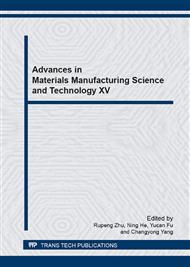[1]
WU Qiye, WU Jingan. Polymer Rheology[M]. Beijing: Higher Education Press (2002).
Google Scholar
[2]
Taha Sochi: Journal of Polymer Science: Part B: Polymer Physics Vol. 48 (2010), p.2437.
Google Scholar
[3]
HUANG Weili, LI Huiping, HU Zizhao, et al: Contemporary chemical industry Vol. 41 (2012), p.41.
Google Scholar
[4]
R.C.R. Figueredo, E. Sabadini: Colloids and Surfaces A:Physicochem. Eng. Aspects Vol. 215 (2003), p.77.
Google Scholar
[5]
WANG Zhendong: Mechanics in Engineering Vol. 20 (1998), p.72.
Google Scholar
[6]
D. Mowla, A. Naderi: Chemical Engineering Science Vol. 61 (2006), p.1549.
Google Scholar
[7]
Rebeka Fijan, Michele Basile, Romano Lapasin: Carbohydrate Polymers Vol. 78 (2009), p.25.
Google Scholar
[8]
LIU Bin. Study on modified viscous fluid and its damper [D]. Southeast University, (2007).
Google Scholar
[9]
Spencer BF jr., Dyke SJ, Sain MK, Carlson JD: J Engng Mech ASCE Vol. 123 (1997), p.230.
Google Scholar
[10]
CHENG Tao. Study on Mechanical modeling of carrier-based aircraft arresting cable on magneto-rheological damper [D], Shenyang Aerospace University, (2011).
Google Scholar
[11]
Cristiano Spelta, Fabio Previdi, Sergio M. Savaresi, et al: Mechatronics Vol. 19(2009), p.410.
Google Scholar
[12]
Ioan Bica: Journal of Magnetism and Magnetism and Magnetic Materials Vol. 270 (2004), p.321.
Google Scholar
[13]
Lee, Y.S., Wetzel, E.D., Wagner, N.J. Journal of Materials Science Vol. 38(13) (2003), p.2825.
Google Scholar
[14]
R.G. Egres Jr., Y.S. Lee, J. E. Kirkwood, et al: IFAI 4th Int. Conf. on Safety and Protective Fabrics. Pittsburgh: PA, (2004).
Google Scholar
[15]
SUN Xiwei, ZHANG Feihu, DONG Shen, et al: New Technology & New Process Vol. (2) (2006), p.73.
Google Scholar
[16]
Loan Bica, Ying Dan Liu, Hyoung Jin Choi: Journal of Industrial and Engineering Chemistry Vol. 19 (2013), p.394.
Google Scholar
[17]
T. Kuriyagawa, M. Saeki, K. Syoji: Journal of the International Societies for Precision Engineering and Nanotechnology Vol. 26 (2002), p.370.
Google Scholar
[18]
W.B. Kim, B. -K. Min, S.J. Lee: Journal of Materials Processing Technology Vol. 155-1566 (2004), p.1293.
Google Scholar
[19]
TANG Yong, ZHOU Deming, XIA Wei, et al: Journal of South China University of Technology (Nature Science Edition) Vol. 29 (1) (2001), p.34.
Google Scholar
[20]
JI Shiming, LI Chen, TAN Dapeng, et al: Journal of Mechanical Engineering Vol. 47(17) (2011), p.156.
Google Scholar


